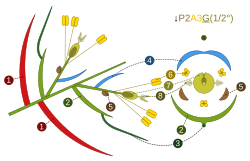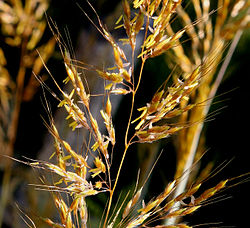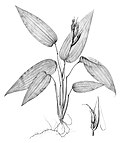Poaceae
The Poaceae or Gramineae are the "true" grasses. They are a large family of monocot flowering plants. There are about 12,000 species and 780 genera. They are one of most ecologically and economically important of all plant families.[1] Rushes and sedges fall outside this family, but they are related.
| Poaceae | |
|---|---|

| |
| Flowering head of meadow foxtail (Alopecurus pratensis) | |
| Scientific classification | |
| Kingdom: | |
| Division: | |
| Class: | |
| Order: | |
| Family: | Poaceae
|
Grasslands are about 20% of the vegetation cover of the Earth. Poaceae also live in many other habitats, including wetlands, forests, and tundra. Bamboos are part of this huge family of plants.
Domesticated poaceous cereal crops (maize (corn), wheat, millets, and rice) are eaten around the world. The Poaceae are the most economically important plant family in modern times. They are used for forage, building materials (bamboo, thatch) and fuel (ethanol), as well as food.
Grasses include some of the most useful plant life-forms. They became widespread towards the end of the Cretaceous period. Fossilized dinosaur dung (coprolites) have been found with phytoliths of grasses which are related to rice and bamboo.[2] Grasses have adapted to conditions in lush rain forests, dry deserts, cold mountains and even intertidal habitats. They are at present the most widespread plant type. Grass is a valuable source of food and energy for wildlife as well as humans.
Poaceae Media
Illustration depicting both staminate and pistillate flowers of maize (Zea mays)
Sugarcane (Saccharum officinarum)
Drawing of Anomochloa marantoidea, one of the most primitive living grass species
Wind-blown grass in the Valles Caldera in New Mexico, United States
A kangaroo eating grass
References
- ↑ Stevens, P.F. "Angiosperm Phylogeny Website". Retrieved 2007-10-07.
- ↑ Piperno, Dolores R.; Sues, Hans-Dieter 2005. Dinosaurs dined on grass. Science (journal) 310 (5751): 1126–1128. doi:10.1126/science.1121020. PMID 16293745. S2CID 83493897
| Wikispecies has information on: Poaceae. |









